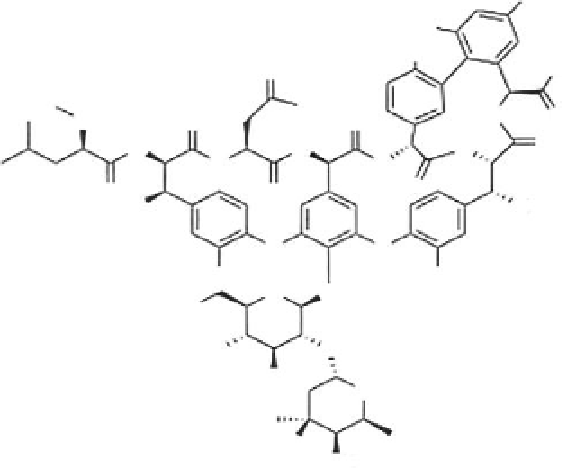Chemistry Reference
In-Depth Information
OH
HO
OH
OH
O
NH
2
HN
O
NH
O
O
N
N
N
O
H
H
O
O
O
HO
OH
O
O
Cl
Cl
O
O
HO
O
HO
OH
O
H
2
N
OH
FIGURE 7. 7
Structure of the cyclic peptide vancomycin.
7.1.4 d
eteCtion
of
a
mino
a
CidS
Many of the amino acids do not possess a chromophore and therefore are not easily
visualized by ultraviolet (UV) detection after high-performance liquid chromatog-
raphy (HPLC) or thin layer chromatography (TLC) separation. Several fluores-
cent reagents have been used to “tag” amino acids and enhance their detection at
extremely low levels. However, one versatile and effective way to detect amino acids
and peptides is by the use of ninhydrin (Figure 7.8).
The reaction of a free amine
with ninhydrin produces a deep blue or purple color when used as a spray reagent to
detect amino acids (for example, using TLC, the plate is sprayed with reagent and
amino acids appear as purple spots).
7.2 INDOLES AND ALKALOIDS
Indole (Figure 7.9) has a bicyclic structure: a six-membered benzene ring fused to a
ive-membered nitrogen-containing pyrrole ring. Indole, a major constituent of coal-
tar obtained by distillation at ~250°C, is used as a common component of fragrances
and the precursor to many pharmaceuticals. Synthetic routes have been devised to
obtain indoles starting from aniline and ethylene glycol in the presence of catalysts,
as shown in Figure 7.10.
One of the more important natural indole compounds, found in the brain, is the
amino acid tryptophan, which acts as the precursor of the neurotransmitter serotonin
(Figure 7.11). The pathway for the synthesis of serotonin from tryptophan is shown
in Figure 7.12.

Search WWH ::

Custom Search